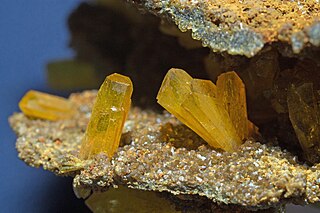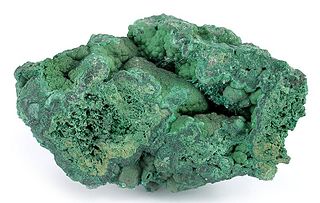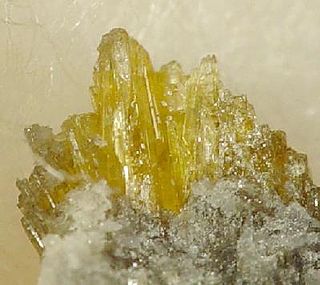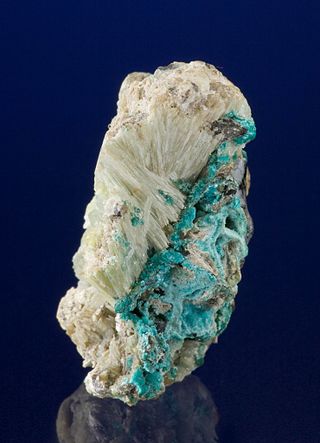
Germanite is a rare copper iron germanium sulfide mineral, Cu26Fe4Ge4S32. It was first discovered in 1922, and named for its germanium content. It is only a minor source of this important semiconductor element, which is mainly derived from the processing of the zinc sulfide mineral sphalerite. Germanite contains gallium, zinc, molybdenum, arsenic, and vanadium as impurities.

Dioptase is an intense emerald-green to bluish-green mineral that is cyclosilicate of copper. It is transparent to translucent. Its luster is vitreous to sub-adamantine. Its formula is Cu6Si6O18·6H2O, also reported as CuSiO2(OH)2. It has a Mohs hardness of 5, the same as tooth enamel. Its specific gravity is 3.28–3.35, and it has two perfect and one very good cleavage directions. Additionally, dioptase is very fragile, and specimens must be handled with great care. It is a trigonal mineral, forming six-sided crystals that are terminated by rhombohedra.

Mimetite is a lead arsenate chloride mineral (Pb5(AsO4)3Cl) which forms as a secondary mineral in lead deposits, usually by the oxidation of galena and arsenopyrite. The name derives from the Greek Μιμητής mimetes, meaning "imitator" and refers to mimetite's resemblance to the mineral pyromorphite. This resemblance is not coincidental, as mimetite forms a mineral series with pyromorphite (Pb5(PO4)3Cl) and with vanadinite (Pb5(VO4)3Cl). Notable occurrences are Mapimi, Durango, Mexico and Tsumeb, Namibia.

Seligmanite is a rare mineral, with the chemical formula PbCuAsS3. Originally described from the Lengenbach Quarry, Valais Canton, Switzerland; it has also been found in the Raura district, Lima Region, Peru; at Tsumeb, Oshikoto Region, Namibia; and at the Sterling Mine, Sussex County, New Jersey, US.

Fraipontite is a zinc aluminium silicate mineral with a formula of (Zn,Al)3(Si,Al)2O5(OH)4.

Legrandite is a rare zinc arsenate mineral, Zn2(AsO4)(OH)·(H2O).

Patrónite is the vanadium sulfide mineral with formula VS4. The material is usually described as V4+(S22−)2. Structurally, it is a "linear-chain" compound with alternating bonding and nonbonding contacts between the vanadium centers. The vanadium is octa-coordinated, which is an uncommon geometry for this metal.

Kegelite is a complex silicate mineral with formula Pb8Al4Si8O20(SO4)2(CO3)4(OH)8.
Reinerite is a rare arsenite (arsenate(III)) mineral with chemical formula Zn3(AsO3)2. It crystallizes in the orthorhombic crystal system.

Duftite is a relatively common arsenate mineral with the formula CuPb(AsO4)(OH), related to conichalcite. It is green and often forms botryoidal aggregates. It is a member of the adelite-descloizite Group, Conichalcite-Duftite Series. Duftite and conichalcite specimens from Tsumeb are commonly zoned in color and composition. Microprobe analyses and X-ray powder-diffraction studies indicate extensive substitution of Zn for Cu, and Ca for Pb in the duftite structure. This indicates a solid solution among conichalcite, CaCu(AsO4 )(OH), austinite, CaZn(AsO4)(OH) and duftite PbCu(AsO4)(OH), all of them belonging to the adelite group of arsenates. It was named after Mining Councilor G Duft, Director of the Otavi Mine and Railroad Company, Tsumeb, Namibia. The type locality is the Tsumeb Mine, Tsumeb, Otjikoto Region, Namibia.

Bayldonite (BAIL-done-ite) is a rare secondary mineral with the chemical formula PbCu3(AsO4)2(OH)2. Its provenance has been attributed to Penberthy Croft Mine, Cornwall, England, United Kingdom but there is no substantiating evidence for this and it was only attributed to Cornwall by Church (1865). Also, Church’s paper (Church, 1865) clearly states “I am indebted to Mr. Talling for this mineral species also.” so the original material was supplied by the mineral dealer Richard Talling and not discovered by Bayldon. Bayldonite was named after Church's dear friend and colleague at the Royal Agricultural College (RAC),Cirencester, Gloucestershire John Bayldon MD (1837 – 1872). Specimens are also found in Tsumeb, Namibia, and Arizona, United States. It is sometimes used as a gemstone.
Sewardite is a rare arsenate mineral with formula of CaFe3+2(AsO4)2(OH)2. Sewardite was discovered in 1982 and named for the mineralogist, Terry M. Seward (born 1940), a professor of geochemistry in Zürich, Switzerland.

Warikahnite is a rare zinc arsenate mineral of the triclinic crystal system with Hermann-Mauguin notation 1, belonging to the space group P1. It occurs in the Tsumeb mine in Namibia on corroded tennantite in the second oxidation zone under hydrothermal conditions in a dolomite-hosted polymetallic ore deposit. It is associated with adamite, stranskiite, koritnigite, claudetite, tsumcorite, and ludlockite. The origin of discovery was in a dolomite ore formation within an oxidized hydrothermal zone, in the E9 pillar, 31st level of the Tsumeb Mine in Namibia, Southwest Africa. It has also been found at Lavrion, Greece and Plaka, Greece as microscopic white needles.

Tsumcorite is a rare hydrated lead arsenate mineral that was discovered in 1971, and reported by Geier, Kautz and Muller. It was named after the TSUMeb CORporation mine at Tsumeb, in Namibia, in recognition of the Corporation's support for mineralogical investigations of the orebody at its Mineral Research Laboratory.

Susannite is a lead sulfate carbonate hydroxide mineral. It has the formula Pb4SO4(CO3)2(OH)2. Susannite is the higher temperature phase of the two and forms above 80 °C when fluids oxidize the lead ore deposits. It is trimorphous with leadhillite and macphersonite.

Ianbruceite is a rare hydrated zinc arsenate with the formula [Zn2(OH)(H2O)(AsO4)](H2O)2; material from the Driggith mine has traces of cobalt. It was first discovered at Tsumeb, approved by the International Mineralogical Association as a new mineral species in 2011, reference IMA2011-49, and named for Ian Bruce, who founded "Crystal Classics" in the early 1990s, and was heavily involved in attempts to reopen the famous Tsumeb mine for specimen mining.
In 2013 new occurrences of ianbruceite were reported from the neighbouring Driggith and Potts Gill mines on High Pike in the Caldbeck Fells, Cumbria, England. Here the mineral is probably a post-mining product. Caldbeck Fells and Tsumeb are the only reported localities for ianbruceite to date (May 2013).
Bartelkeite is an exceptionally rare mineral, one of scarce natural germanium compounds. The formula was originally assumed to be PbFeGe3O8, bartelkeite was later shown to be isostructural with a high-pressure form of the mineral lawsonite. Thus, its correct formula is PbFeGe(Ge2O7)(OH)2•H2O. Bartelkeite and mathewrogersite are minerals with essential (dominant) lead, iron and germanium. Both come from Tsumeb, Namibia - a world's "capital" of germanium minerals.

Minrecordite, CaZn(CO3)2, is a very rare mineral belonging to the dolomite group, the member with Ca and Zn. It was discovered, associated with dioptase, in a specimen from the Tsumeb mine (Namibia), which is consequently its type locality. Its name is a tribute to The Mineralogical Record magazine, representing the collaboration between professional and amateur mineralogists. In this locality it is associated primarily with dioptase, and less frequently with duftite, calcite and malachite. It is a rare mineral, which has been found only in a few deposits in the world. In addition to the type locality, it appears in the Preguiça mine, in Moura, district of Beja (Portugal).
Yangite (PbMnSi3O8·H2O) is a chain-silicate mineral, first discovered within the Kombat mine in Namibia. The mineral is named after Hexiong Yang, a researcher at the University of Arizona's Department of Geosciences. Yangite was approved as a valid mineral species by the International Mineralogical Association in 2012.
Gallobeudantite is a secondary, Gallium-bearing mineral of beudantite, where the Iron is replaced with Gallium, a rare-earth metal. It was first described as a distinct mineral by Jambor et al in 1996. Specific Gallium minerals are generally rare and Gallium itself is usually obtained as a by-product during the processing of the ores of other metals. In particular, the main source material for Gallium is bauxite, a key ore of aluminium. However, Gallobeudantite is too rare to be of economic value. Its main interest is academic and also among mineral collectors.















